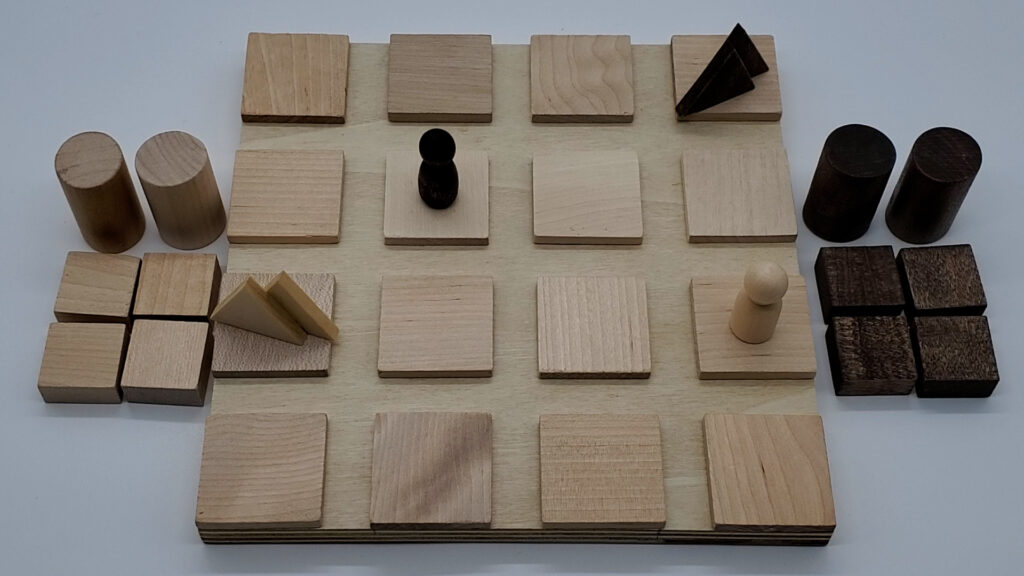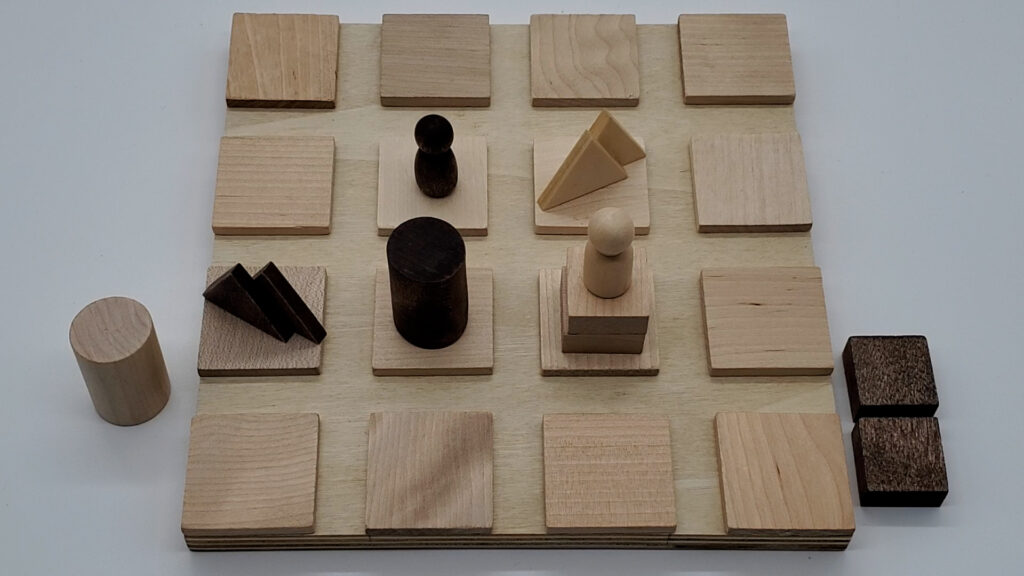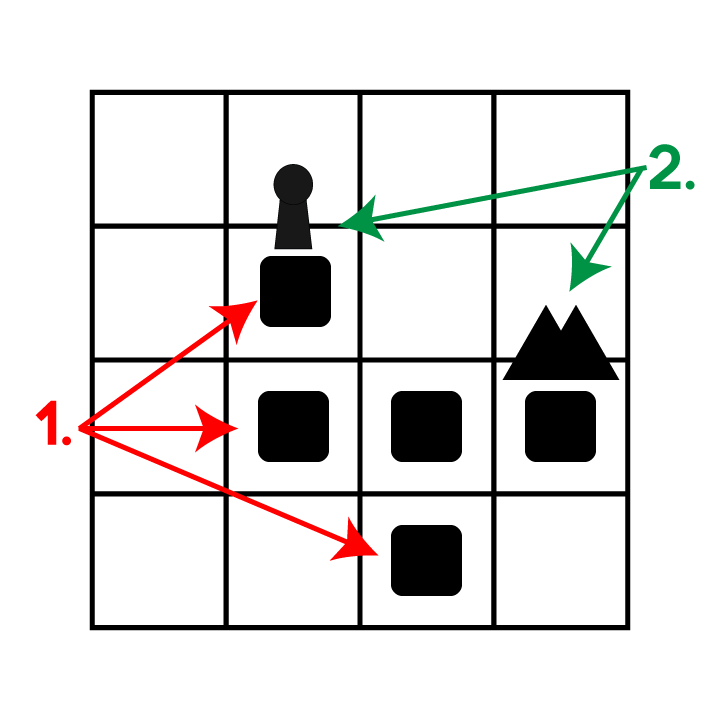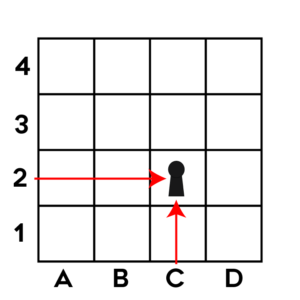The Rules of
Draagostat
(A Game Of Dominion)
UPDATE: Dominion has been renamed to “Draagostat (A Game Of Dominion).”
Version: 2.0
Last revised: 3/1/24
First publication: 10/28/23
Legalese: This is an original work. This document and ruleset are protected by pertinent copyright laws. All rights reserved.
Visual Guide: A video guide to this official rulebook can be found here.


TABLE OF CONTENTS
OVERVIEW
DRAAGOSTAT (A Game Of Dominion) is a strategy game for 2 players. You’re a builder working hard to establish a city of beautiful buildings and mighty citadels, trying to do so before your rival establishes theirs, thus gaining dominance over the land. And…your rival controls a dragon which is trying to burn down your buildings. Not to worry, you have one too!
TL;DR – You’re playing against an opponent. On your turn, you either lay a building, move a builder, or move a dragon. First to create a connecting 5-building city wins the game.
CONTENTS
- 1 4×4 Board
- 2 Builders – 1 Dark, 1 Light
- 2 Dragons – 1 Dark, 1 light
- 8 One-Story Buildings – 4 Dark, 4 Light
- 4 Citadels – 2 Dark, 2 Light
- 2 8-Sided Dice – One with letters, the other with numbers.
ESTIMATED TIME OF GAME PLAY
- 5 to 15 minutes, depending on how fast you light up your opponent!
Game Play
OBJECTIVE
- Build a 5-building city.
- Perch your builder and dragon on top of the city.
The first to complete both tasks wins the game.

SETUP
To set up the game, you’ll be placing the builders and dragons on the gameboard on random squares. If you look at the board, it creates a grid. Starting from the bottom left corner, the columns are identified with letters from left to right. The rows are identified with numbers from bottom to top (Diagram 1).
Starting with the dark builder:
- Roll the 2 8-sided dice. The roll determines the coordinates where the dark builder will be placed.
- Place the dark builder on the rolled coordinates. For example, lets say a ‘C’ and a ‘2’ were rolled, so the dark builder is placed on square C2 (Diagram 2).
- Repeat Steps 1 and 2 for the light builder, dark dragon, and light dragon respectively. If there is a piece already on the rolled coordinates, simply re-roll.
- Both players start with a resource pool containing:
- 4 buildings of their color
- 2 citadels of their color

Diagram 1 – The board makes a 4×4 grid.

Diagram 2 – Dark builder placed on square C2.
PLAYING THE GAME
- The player controlling the dark pieces gets first turn.
- On a player’s turn, they perform one of three actions:
- Move
- Build
- Attack
- Players take alternating turns until the game is over.
—
- Moving The Builder:
- A builder may move onto any empty orthogonal square. A builder may not move diagonally.
- A builder may move onto a square that has a building or citadel of its own color. A builder may not move onto a square that has a building or a citadel of the opposite color. (There is one exception to this rule. See Attacking section below.)
- A builder may move onto a square that has their own dragon on it, i.e., a builder and dragon of the same color may occupy the same square. It’s alright if the square has no buildings, or a building or a citadel of the same color on it.
—
- Moving The Dragon:
- A dragon may move onto any empty orthogonal square. A dragon may not move diagonally.
- A dragon may move onto a square that has a building or citadel of any color.
- A dragon may move onto a square that has their own builder on it. A builder and dragon of the same color may occupy the same square. It’s alright if the square has no buildings, or a building or a citadel of the same color on it.
—
- Building:
- If a builder is on an empty square, it may build a one-story building underneath itself.
- If a builder is on a square that already has a one-story building, it may:
- Build a second-story to that building.
- Deconstruct that building and place it back into their resource pool.
- If a builder is on a square that already has a second-story building, it may:
- Convert that second-story building into a citadel (subject to the “Citadel Delay” rule below) and return the two buildings to their resource pool.
- Move to an empty orthogonal square (i.e. with no buildings or pieces on it) carrying along the second story of the existing building only, thus creating an new one-story building on the empty square and leaving another one-story building behind. However, a builder may not do the reverse, i.e. it cannot carry a one-story building over to a square that also has an existing one-story building in order to build a new two-story building.
- Deconstruct the second story, placing it back into their resource pool. The first story remains.
- You may not build a third story.
- If a builder is on a square that has a citadel, you may not build any more above it. Also, a citadel may not be de-converted back to a two-story building, i.e. a citadel is permanent.
- If a builder is on the same square as its dragon, the builder cannot build underneath, nor convert a two-story building into a citadel, nor deconstruct one or two story buildings.
WINNING THE GAME
The first player to build a city of 5 connecting buildings and citadels then move their builder and dragon on top of them, gets to declare “Dominion!” and wins the game.
- The 5 buildings and citadels must be connected orthogonally. No connection may be diagonal.
- A player still wins even if there’s a piece of the opposite color on the 5-building city at the time Dominion is declared.
- A player still wins even if their builder and dragon are on the same building.
Special rules
ATTACKING
- A citadel is the tallest building. It is higher than…
- A two-story building, which is higher than…
- A one-story building, which is higher than…
- An empty square.
- A builder may attack a piece:
- That stands on the same building height as the builder, or lower.
- That sits on a building of opposite color. This is the only time a builder may hop onto an opposite-colored building. On a subsequent move, the builder must move onto an empty square or a square that has their own colored building on it. The builder may not move onto another square with an opposite-colored building.
- A dragon may attack a piece that stands at any height.
When a piece is attacked, it gets placed onto any empty square by the attacking player. Empty, meaning devoid of only buildings. Builders or dragons may be on the banishing square.
- If Player 1 (P1) has two citadels in play and attacks Player 2’s builder (B2), B2 is placed on top of one of P1’s citadels where it’s “held captive.”
- B2 may be placed on a citadel that has another piece perched on it.
- B2 cannot move from the citadel until its dragon (D2) reaches the citadel. Once D2 reaches the citadel thereby “rescuing” the builder, B2 can be placed by Player 2 (P2) on any empty space or any space that has buildings of their color.
- If any of Player 1’s pieces are perched on the citadel at the time of rescue, that piece gets attacked by D2. P2 gets to both place their rescued builder on any empty square, or any square that has buildings of their color; and place the attacked piece onto any empty square.
Capturing the builder is optional. You still have the option to banish the builder to an empty square instead.
ATTACKING
- A citadel is the tallest building. It is higher than…
- A two-story building, which is higher than…
- A one-story building, which is higher than…
- An empty square.
—
- A dragon may attack a piece that stands at any building height.
- A builder may attack a piece:
- That stands on the same building height as the builder, or lower.
- That sits on a building of the opposite color (subject to the building height restrictions above). This is the only time a builder may hop onto an opposite-colored building. On a subsequent move however, the builder next move must be onto an empty square or a square that has a building of their own color on it. The builder may not move onto another square with an opposite-colored building.
—
When a piece is attacked, it gets placed onto any empty square by the attacking player.
DESTRUCTION
- If a dragon lands on a building of the opposite color, one story of that building is “destroyed” and the piece is returned to its owner’s resource pool.
- For a one-story building, the building is complete gone and the square is empty again.
- For a two-story building, only the top story is destroyed, but the bottom story remains.
- A citadel can never be destroyed.
- Building Protection Rule: If a dragon attacks a space that has a building on it, and that building has a builder or dragon on top of it, only the attacked builder or dragon is moved. The building stays intact.
PERCHING
- A dragon may move onto any square that has a citadel of any color, i.e. “perch” on top of it.
- If a dragon is perched on top of a citadel, it may fly itself onto any other citadel of any color.
- Flying from citadel to citadel counts as one turn.
RIDING THE LIGHTNING
- If a player’s dragon sits on a corner square, on that player’s next turn, their dragon may teleport to any other corner that is empty or has a building of its own color. It cannot teleport to a corner that has a building of the opposite color.
- Teleporting counts as one turn.
CITADEL ZONE FREEZE
No more than two citadels may be built on the center 4 squares. They may both be dark, or both be light, or 1 dark and 1 light, but no more than two total.
CITADEL DELAY
- At the start of the game, a player cannot establish a citadel on their starting square. A player must move their builder at least once off its starting square before they may convert any two-story building to a citadel, i.e. they cannot be on their starting square, then in the three turns, build a two-story building then convert it to a citadel. However, a builder may move off its starting square, move back to its starting square, then start to build a citadel. In this case, since it has moved at least once, it’s no longer subject to citadel freeze.
RIGHT OF FIRST CONVERSION
- No consecutive citadel conversions are allowed. For example, lets say both builders are sitting on two-story buildings and are ready to convert to citadels. If the dark builder converts first, the light builder cannot convert on its next turn. That would be two consecutive citadel conversions. The light builder would have to do something else on their current turn, including just moving their dragon, but will be able to convert on the subsequent turn.
DRAW BY REPETITION
- If there is a situation where both players are going back and forth repeating the same moves, once there is a threefold repetition of the initial position, the round is a draw by repetition.
- However, if a player plays a different move before the initial position is repeated for the third time, there is no draw and play continues.
Expansion Rules
The following rules aren’t part of the main ruleset. They’re optional and are experimental for the time being. You might want to add them to your game to spice things up.
WITHOUT CORNERS
The winning 5-building city may not include corners. Add this if you want an extra challenge.
WITH DIAGONALS
The winning 5-building city may include buildings connected diagonally. You may limit this to 1, 2, 3, or 4 buildings being able to connect diagonally, or allow all 5 to do so. This may be used in conjunction with the With Corners rule above. Use this if you find the regular game too “grindy.”
Appendix
APPENDIX ITEM 1
Description here…
Copyright 2023-2024